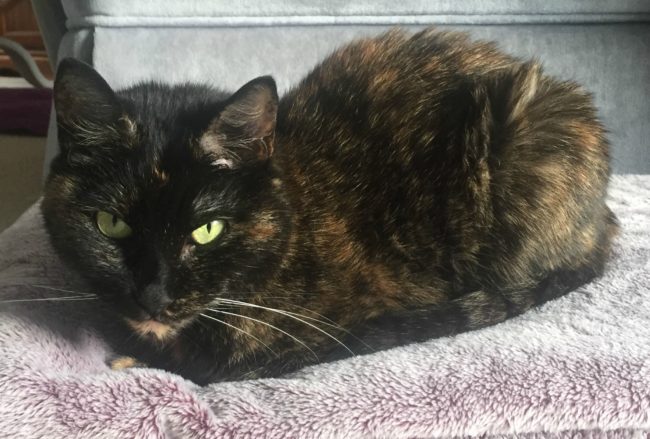
This post contains affiliate links*
This is the third part in a four-part series about my experience during the last four months of Ruby’s life, from diagnosis to caring for her through her illness, to having to let her go. Click here to read part one, Ruby’s Last Journey: The Moment That Changed Everything and part two, Ruby’s Last Journey: Practical Considerations of Hospice Care.
Cats with kidney disease need water
Hydration is critical for all cats, but especially for cats with kidney disease. Cats with chronic kidney disease pass large amounts of urine and become easily dehydrated. Dehydration can be prevented by feeding canned or raw food, and by encouraging cats to drink.
Failing kidneys lose the ability to concentrate urine, which is why cats with kidney disease will pee more frequently and will pee larger amounts. Consequently, these cats will need more water to make up for what they lose through urination. Human patients with kidney disease often report excessive thirst, especially during the latter stages of the disease.
I never saw Ruby drink much water before she got sick. The rare time that I did see her drinking out of the water bowl, she had quite an elaborate ritual. First, she would dip one paw into the bowl and flings some water out of the bowl. Then she would repeat the same thing with her other paw. Then, she would lick her paws. It was only after she apparently satisfied herself that yes, there was indeed water in her bowl (and after she had made a big mess all around her bowl!) that she would settle down and take a nice long drink of water.
Now that she was sick, that was a terribly inefficient way to get enough water, and in the early days of her illness, her frustration showed. It was almost like she had forgotten how to drink at times. No longer content with just flinging water out of the bowl, she would drag the bowl across the kitchen floor. Sometimes there’d be so much water on the floor, I would have to mop it. I experimented with different bowls. I tried large, shallow bowls. I tried elevating her bowl. I tried small, shallow bowls. Nothing seemed to work. She tipped the elevated bowls over. She flung all the water out of the shallow bowls so that nothing was left in the bowl.
I placed additional water bowls around the house, but she only ever drank out of the bowls in the kitchen. For several mornings in a row, I found her in the kitchen sink. I tried turning the tap on for her, but she didn’t like that. I placed a bowl in the sink, and for a few days, she happily drank out of that bowl – and it certainly made things less messy!
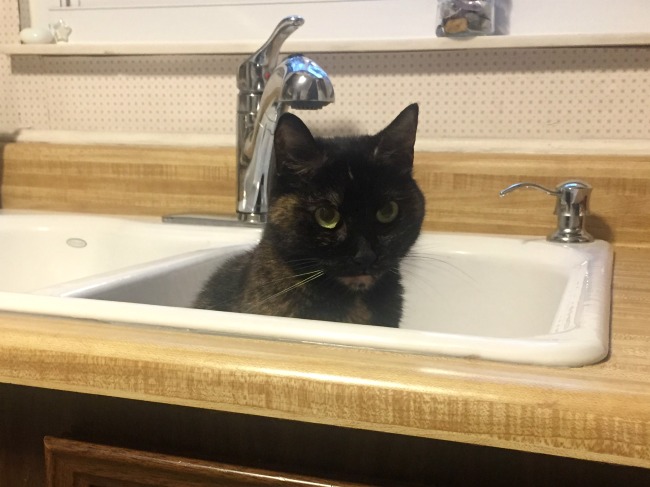
Since neither of the girls were big drinkers, I had never bothered with a fountain. I reviewed fountains over the years, but after the initial curiosity factor, the girls stopped using them, so I donated them to rescue groups. But I had to find a way to make getting water easier for Ruby, so I tried fountains again. In mid-November, we received a Catit LED Flower Fountain for review. The timing couldn’t have been better. Unfortunately, Ruby seemed to have trouble with the height of the fountain.
It wasn’t until I got the smaller Catit Mini Flower Fountain that the problem was finally solved. She loved this fountain, and while she still dipped her paw in it at first before drinking, she quickly settled for nice long drinks of water. I periodically unplugged the fountain when she was napping, and if I didn’t pay attention, I’d find her sitting by the fountain staring at it, trying to figure out why the water wasn’t moving. Needless to say, I stopped unplugging it!
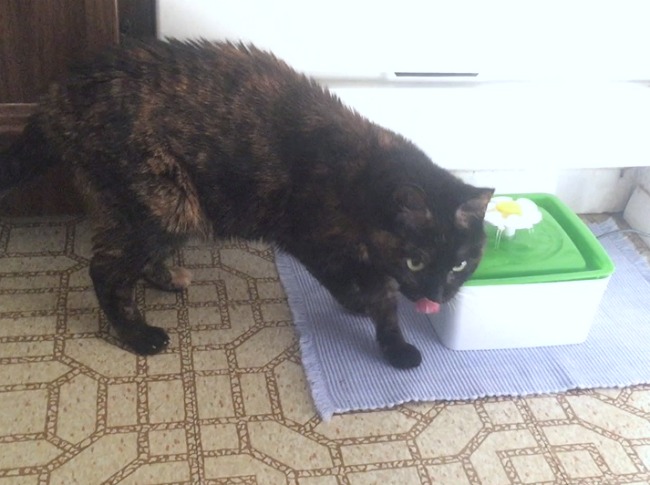
Ruby’s relentless thirst was hard for me to watch. There were times when she would wake up from a deep sleep on my lap, and race to the kitchen to get a long drink of water. She sometimes crouched near the water bowl or fountain for extended periods of time, as if it was too much effort to walk away and then have to come back to it when the thirst kicked in again. I suspect that she felt the raging thirst reported by human kidney patients.
Subcutaneous fluids
Subcutaneous fluid administration is another way to help cats with kidney disease get enough water. It provides additional fluid intake and aids in flushing waste products through the kidneys.
Your vet will choose the type of fluid your cat will receive. The frequency of fluid administration will be determined by how advanced your cat’s renal disease is and can range from once a week to every day. Fluids are administered under the cat’s skin. The fluids will pool in a little “lump” and will be gradually absorbed by your cat’s body over the course of a few hours. Based on Ruby’s lab values and symptoms, she should have gotten fluids every day.
I wasn’t sure whether Ruby would be amenable to this procedure, and before I even started, I made a commitment to her and to myself that if she fought it, I was not going to do it. I did not want our remaining time to be marked by a daily event that she would dread.
I was always comfortable with giving fluids in my years working at veterinary hospitals. Amber needed fluids a couple of times throughout her life, and I was able to do it by myself. I had the ideal set up to give Ruby fluids in my Reiki room: a soft massage table covered with a blanket, a floor lamp next to it to hang the IV bag from, and good lighting, so I could easily see where I was inserting the needle.
The first time I gave Ruby fluids, I had to fight my own nervousness so she wouldn’t pick up my energy. Thankfully, she tolerated it well. Other than a slight flinch when I inserted the needle, she sat still for the minute or two it took. She was a small cat, so she only needed about 75ml per session.
She did okay the second and third time. By the fourth time, she’d had enough, and cried out and scooted away from me as soon I placed her on the Reiki table. I knew if I wanted to keep going with it, I would need help. I was fortunate that my friend Renee, the owner of Whimsy Cats Specialized Cat Sitting, provides assistance with fluid therapy in the cat’s home as part of her regular services. With Renee’s help, I was able to gently hold Ruby while Renee inserted the needle.
Most of the time, things went smoothly, but there were times when Ruby cried out when the needle was inserted, or tried to get away from us. Every single one of those times, I questioned whether we should keep going. But every single time, as soon as we finished, Ruby would be all over Renee, rubbing up against her and loving on her, and then doing the same with me. Weighing the moment of inserting the needle and the minute or so of getting the fluids against the additional time regular fluid therapy bought us seemed like an acceptable trade off.
The fluids were making a difference. On “fluid days,” Ruby would spend less time at the fountain or water bowl. She seemed to have a little more energy. Ideally, she should have gotten fluids every day. However, we felt that that would be pushing our luck with daily administration. We chose to only do it every other day so Ruby would have a break in between.
For the next two months, Renee came to my house every other day. In addition to making fluid therapy possibly, her visits, like Dr. Tasi’s weekly visits, also served as another check in point for me. Was my assessment of Ruby’s health status accurate, or was I in denial? Getting Renee’s “read” on Ruby so frequently helped immeasurably.
A week or two before I had to let Ruby go, she was more and more upset about getting her fluids. We switched things up a bit. Renee held her on her lap and I inserted the needle. That worked better for a couple of times, until it didn’t. Two days before I let Ruby go, and after discussing it with Dr. Tasi, I made the decision to stop fluid therapy. At that point, it was becoming clear to me that continuing to do something that would prolong Ruby’s life when it was so obvious that she was declining rapidly was insane.
Deciding whether to do fluid therapy, and how frequently, should be decided by the cat’s veterinarian, but will also depend on each cat’s personality and tolerance level. Administration is going to be easier if you have a second person to help. Some cats are fine with frequent trips to the vet’s office to have fluids administered in the clinic. I believe that the most important factor when making this decision is to take your cat’s temperament and your relationship into account. If the therapy damages your bond, it’s not worth it.
Coming next week:
Ruby’s Last Journey: The Long Goodbye
*The Conscious Cat is a participant in the Amazon Services LLC Associates Program, an affiliate advertising program designed to provide a means for us to earn fees by linking to Amazon.com and affiliated sites. This means that if you decide to purchase through any of our links, we get a small commission. We only spread the word about products and services we’ve either used or would use ourselves.


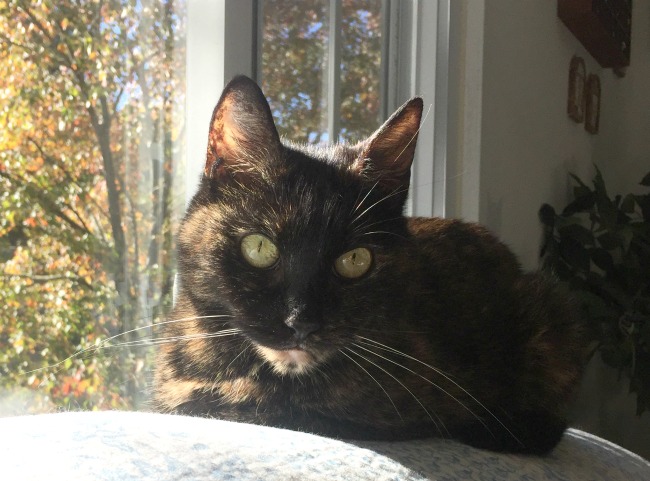
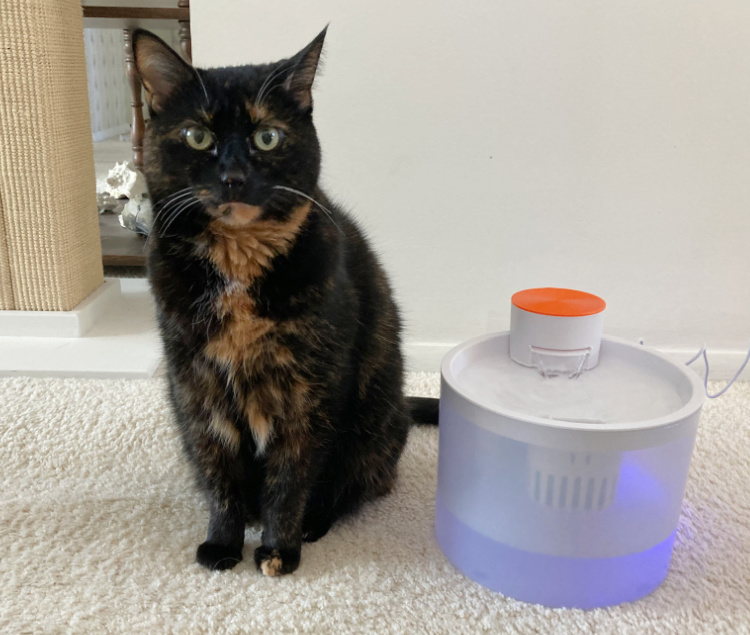
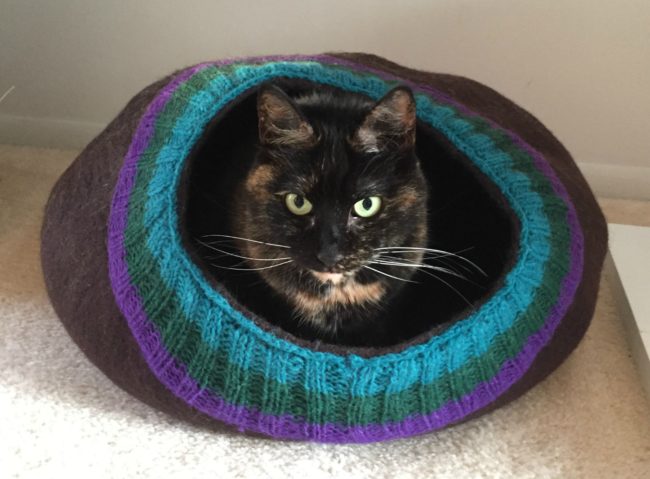
Generally cats prefer drinking running water from showers or taps over the supply in their bowls, there are some evolutionary reasons to support their preference. Let’s look at some of those reasons:
Cats are biologically programmed not to drink water that is placed near the food or toilet area because their instincts say it might be contaminated.
Felines have an acute sense of hearing, a running tap of water catches their immediate attention than the sight of stale stationary water.
The size of the bowl in which you serve them water could also be the root cause of this problem. Many times their sensitive whiskers rub against the sides of the bowl, and it irritates them.
Dripping water is more fun to play with than splashing around in the bowl.
I’ve been following this entire series and it has helped me heal from my experience with my beloved cat’s death due to kidney disease. It happened in 2017 but sometimes it feels like it happened only yesterday. Your stories are sweet and touching. Thank you for sharing them…Ruby was a beautiful girl <3
Of my cats that have had kidney disease, three in particular come to mind. The ladies were 13 years old, Winston’s age as an adult foundling was unknown.
I used subcutaneous fluids with Missy, twice per week. She didn’t like it much but at least tolerated it. It gave her an extra year of life with reasonable quality. When the end came, she went every where with me during her last week (even to work) and she passed peacefully at home. I gave her unused supplies to a lady I met at the vet’s whose young cat had just been diagnosed.
Jasmine was a Bengal and slow to show signs of distress, so her case was quite advanced by the time she was diagnosed. She was not a cat who wanted to ever be held (her original owner was my sister who had passed away). We did not even try fluids with her as I knew she would not tolerate the process, either at home or the vets, and she was declining rapidly anyway. She passed away at home less than two weeks later.
Winston died of kidney disease way back in the ‘80s. He snuck out the door and disappeared for a couple of days (going to ground) – then reappeared on my porch in the late evening, barely alive and having lost almost half his body weight. I kept him going through the night until the clinic opened in the morning, where he was diagnosed with an almost complete kidney shutdown. I was told to give him canned food & fluids for two weeks to see if his kidneys could rebound at all; when this failed and he kept losing weight, I had to make the difficult decision to put him to sleep. I am grateful he came home so I was not left uncertain as to his fate (I had spent many hours looking for him).
So far my two cats are healthy….one drinks and pees a lot but it does not seem extreme
I put colloidal silver in their water…a dropper full….and I take it too for my immune system
We try to keep our felines that eat only dry prescription food hydrated, by adding some water to their dry just before feeding. It keeps it crunchy for their teeth health, but also adds water to their diet to maintain better water consumption….
I wanted to share how I did sub-q’s by myself with my girl (also a tortie– Des)
I had one of those rectangle plastic containers which I had a towel in (which took up about half the space).When I put her in.. the towel kept her from moving around..which made needle insertion less scary for her and me.
I followed all the typical rules of needle insertion (putting in her “back” near her neck area and let it “fill” til a “lump” of “mediusm” size developed (or by also knowing just how much fluid went in..and how to monitor the valve that allowed for faster or slower water going through the “tube’.
While I initially thought it would make her fight me.. ultimately.. since it made her feel MUCH better.. she became ok with it.. and it became a daily thing… which was fine with her.
I forgot to add:
When giving sub-q fluids..it is VERY important to remember to change location in the scruff of the neck..or elsewhere.. in order to avoid soreness or worse.
I admit I didn’t go to the sub-q management link yet ..so I am sorry if I repeated anything. If I did.. I hope at least it will show that the plan works.
Thank you for sharing these experiences. I lost my Lucy and my Missy, whom I both gave fluids. It was a hard thing to do, since I was needle phobic. I had two cats that needed fluids every couple days, when I was having medical issues myself. Choosing to give your cats sub-q fluids is the gentlest gift of extending their quality of life. You must let your cat give you their preferences. Creating an undeniable bond with your cat is so very important way before you begin sub-q fluids. They will learn to tolerate the treatment and they will trust you.
Cat dads appreciate these stories too.
Thank you for all the information you’ve provided. I appreciate you taking the time to share your experiences.
I’m so sorry you and Ruby had to go through this .
it’s very, very sad.
as cat moms ,we just need to know we did everything we could to give our cats happy lives.
Sometimes giving fluids goes smoothly and then sometimes not, you did terrific with your sweetie though.
You really are the best cat mom. I don’t know if I could do the fluids or even watch if someone else did it. I had a friend (from rescue) give some to Pono a couple times but I couldn’t even be in the same room.
Janine, I’ve given fluids and injections to a number of cats. They don’t mind a needle the way humans sometimes do, because of their feelings. Cats don’t have feelings or fear about needles. The SQ needle for fluids just goes under the skin, not into a muscle. Next time you have an opportunity, stay with the cat and watch. … Unless you are needle phobic yourself?
It’s so hard to keep kitties comfortable and judge what the right approaches are to an illness that you know will just be progressively worse. Fortunately, we are all strong water drinkers here. Binga had kidney disease, but she never needed fluids at home because she drank lots of water.
I cried when I read part 1 and 2 and again now. You are a great mum for doing all these for Ruby and she was a brave little one
Thank you, Ingrid. So many cats develop kidney disease as they get older. I’ve had two, one of whom needed SQ fluids a few times. I put him in a basket the cats liked, which they could climb out of but it slowed him down. Which gave me a moment to offer a treat he liked. His response was just what I wanted; ‘oh a treat, that’s nice, I’ll have one,’ and he’d eat the treat and forget he was wanting to get out of the basket. Now, with a cat with hyperthyroidism and slowly developing CKD ( our vet suggests it’s common) I’ve anticipated the need for more water. The cats taught me that stoneware bowls are the most desirable. The water stays cool longer in stoneware. I have a bowl or two in every room in the house. I have to change the water, giving the bowl a quick scrub with a dish brush, daily. If the water isn’t fresh, Bennie will remind me by sitting there looking at it until I change it. She drinks from every bowl, every time she comes to it. Unless, of course, it’s not fresh enough. I change the water and it’s as if she thinks, “Oh fresh water! How nice. I’ll have some;” and takes a long drink.
I cried when I read part 1 and 2 and again now. You are a great mum for doing all these for Ruby and she was a brave little one